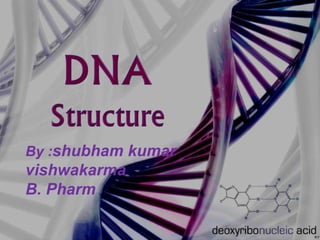
DNA structure
- 1. By :shubham kumar vishwakarma B. Pharm
- 2. DNA stands for deoxyribose nucleic acid This chemical substance is present in the nucleus of all cells in all living organisms DNA controls all the chemical changes which take place in cells The kind of cell which is formed, (muscle, blood, nerve etc) is controlled by DNA Genes are composed of very long strands of DNA the total length of DNA in each cell is about meter. DNA 2
- 3. DNA Structure DNA consists of two molecules that are arranged into a ladder-like structure called a Double Helix. A molecule of DNA is made up of millions of tiny subunits called Nucleotides. Each nucleotide consists of: 1. Phosphate group 2. Pentose sugar 3. Nitrogenous base
- 5. Nucleotides The phosphate and sugar form the backbone of the DNA molecule. There are four types of nitrogenous bases.
- 7. Nucleotides Each base will only bond with one other specific base. Adenine (A) Thymine (T) Cytosine (C) Guanine (G) Form a base pair. Form a base pair.
- 9. DNA Structure The function of DNA is carrying huge amount of information that determine all biological of organism and which is transmitted from one generation to next generation . The bases are arranged in triplets called codons. A G G - C T C - A A G - T C C - T A G T C C - G A G - T T C - A G G - A T C
- 10. DNA Structure A gene is a section of DNA that codes for a protein. Each unique gene has a unique sequence of bases. This unique sequence of bases will code for the production of a unique protein. It is these proteins and combination of proteins that give us a unique phenotype.
- 12. The Shape of the Molecule DNA is a very long polymer. The basic shape is like a twisted ladder or zipper. This is called a double helix. 12
- 13. Two Kinds of Bases in DNA Pyrimidines are single ring bases. Purines are double ring bases. 13 C C C C N N O N C C C C N N N N N C
- 14. Thymine and Cytosine are pyrimidines Thymine and cytosine each have one ring of carbon and nitrogen atoms. 14 C C C C N N O N cytosine C C C C N N O O thymine C
- 15. Adenine and Guanine are purines Adenine and guanine each have two rings of carbon and nitrogen atoms. 15 C C C C N N N Adenine N N C C C C C N N O N Guanine N N C
- 19. DNA Chromatin- DNA histone material is chromatin. The chromatin is supercoilled and packaged into the chromosomes. Histone- the double helix itself twisted wrapped in a highly organized way around structural protein called histone. Centromere-is a region of DNA i.e. is responsible for the movement of the replicated chromosome into the two daughter cell during mitosis & meiosis. Telomere- to protect end of chromosome.
- 20. Chromosome StructureSupercoils within chromosome Histones- Protein that DNA wraps around DNA - Stores genetic information
- 23. Close up of the histones that make the nucleosome
- 24. Diploid cells contain both parental chromosomes. (Ex. every cell other than sex cells in the body) •Haploid cells contain half of the parents chromosomes. (Ex. sperm and egg cells are considered haploid)
- 25. What is a Homologous Chromosome? Homologous chromosomes are the same size and shape carrying the same genes for the same traits. One comes from the father one from the mother.
- 26. Can you find the homologous chromosomes?
- 28. What is a Karyotype? A Karyotype is a picture of chromosomes arranged in homologous pairs from largest to smallest.
- 29. Pairs of Chromosomes from largest to smallest
- 30. Autosomes – are chromosomes that do not determine sex Sex Chromosomes- are chromosomes that determine the sex of the organism. Female = XX and Male =XY
Notes de l'éditeur
- 12